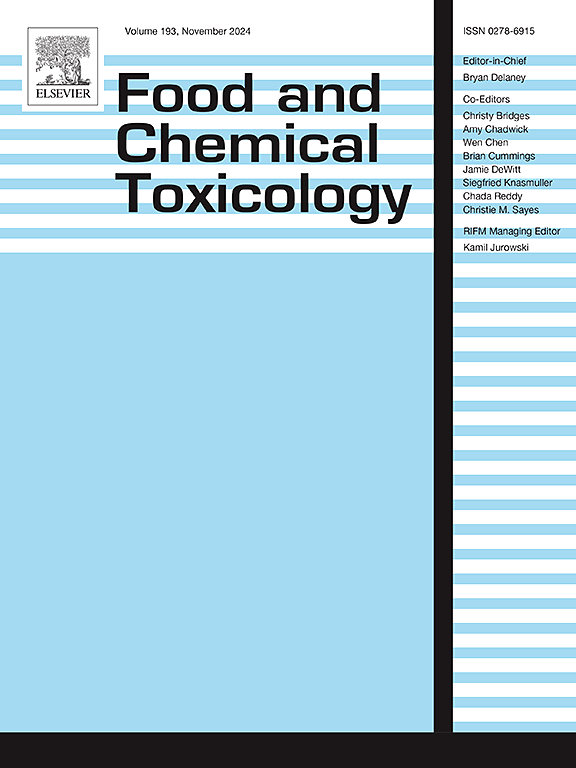一株镰刀菌生产的含磷脂酶活性食品酶的安全性评价
IF 3.9
3区 医学
Q2 FOOD SCIENCE & TECHNOLOGY
引用次数: 0
摘要
磷脂酶是常用的食品酶,例如用于改善面包的制作性能。对于有机食品认证,酶需要由非转基因生物生产,但目前还没有这样的“经典”磷脂酶。为此目的,用镰刀菌公社菌株开发了磷脂酶产品,镰刀菌公社菌株是一种没有在食品工业中使用的微生物。微生物来源的食品酶的安全性在很大程度上取决于生产菌株的安全性。菌株F. commune LFC是通过经典菌株改良获得的。全基因组测序和文献检索允许鉴定真菌毒素beauvericin (BEA), monilformin (MON)和fusaric acid (FA)的潜在基因簇。对这些真菌毒素的分析表明,在受控的水下发酵过程中,没有产生与毒理学相关的水平。酶浓缩物在一系列毒性研究中进行了评估。Ames试验(OECD 471)得出的结论是模棱两可的,但ToxTracker®AO试验提示由剂量依赖性氧化应激诱导的间接作用模式。体外微核试验(OECD 487)和体内后续彗星试验(OECD 489)证实该食品酶无遗传毒性。重复给药口服毒性研究(OECD 408)显示,在任何治疗组中均无不良反应,并允许得出NOAEL为1124 mg TOS/kg bw/day。在人类食品应用中,与估计膳食摄入量的接触边际被确定为>;2500. 综上所述,将磷脂酶LFC用作烘焙和其他谷类食品的加工助剂是安全的。本文章由计算机程序翻译,如有差异,请以英文原文为准。

Safety evaluation of a food enzyme containing phospholipase activity produced by a strain of Fusarium commune
Phospholipases are commonly used food enzymes, e.g. to improve bread-making properties. For organic food certifications, enzymes need to be produced by non-genetically modified organisms, but no such ‘classical’ phospholipases are currently available. To this aim, a phospholipase product was developed with a Fusarium commune strain, a microorganism having no reported uses in the food industry. The safety of microbially-derived food enzymes depends largely on the safety of the production strain. Strain F. commune LFC was obtained by classical strain improvement. Whole-Genome Sequencing and literature search allowed to identify potential gene clusters for the mycotoxins beauvericin (BEA), moniliformin (MON), and fusaric acid (FA). Analysis of these mycotoxins revealed that no toxicologically relevant levels were produced during controlled submerged fermentation. The enzyme concentrate was assessed in a range of toxicity studies. The Ames test (OECD 471) was concluded to be equivocal, but the ToxTracker® AO assay suggested an indirect mode of action, induced by dose-dependent oxidative stress. The in vitro micronucleus test (OECD 487) and the in vivo follow-up Comet assay (OECD 489) confirmed that the food enzyme was not genotoxic. The repeated-dose oral toxicity study (OECD 408) showed no adverse effects in any of the treatment groups and allowed to derive a NOAEL of 1124 mg TOS/kg bw/day. The Margin of Exposure with estimated dietary intakes in human food applications was determined to be > 2500. It is therefore concluded that the use of the phospholipase enzyme LFC as processing aid in baking and other cereal-based applications is safe.
求助全文
通过发布文献求助,成功后即可免费获取论文全文。
去求助
来源期刊

Food and Chemical Toxicology
工程技术-毒理学
CiteScore
10.90
自引率
4.70%
发文量
651
审稿时长
31 days
期刊介绍:
Food and Chemical Toxicology (FCT), an internationally renowned journal, that publishes original research articles and reviews on toxic effects, in animals and humans, of natural or synthetic chemicals occurring in the human environment with particular emphasis on food, drugs, and chemicals, including agricultural and industrial safety, and consumer product safety. Areas such as safety evaluation of novel foods and ingredients, biotechnologically-derived products, and nanomaterials are included in the scope of the journal. FCT also encourages submission of papers on inter-relationships between nutrition and toxicology and on in vitro techniques, particularly those fostering the 3 Rs.
The principal aim of the journal is to publish high impact, scholarly work and to serve as a multidisciplinary forum for research in toxicology. Papers submitted will be judged on the basis of scientific originality and contribution to the field, quality and subject matter. Studies should address at least one of the following:
-Adverse physiological/biochemical, or pathological changes induced by specific defined substances
-New techniques for assessing potential toxicity, including molecular biology
-Mechanisms underlying toxic phenomena
-Toxicological examinations of specific chemicals or consumer products, both those showing adverse effects and those demonstrating safety, that meet current standards of scientific acceptability.
Authors must clearly and briefly identify what novel toxic effect (s) or toxic mechanism (s) of the chemical are being reported and what their significance is in the abstract. Furthermore, sufficient doses should be included in order to provide information on NOAEL/LOAEL values.
 求助内容:
求助内容: 应助结果提醒方式:
应助结果提醒方式:


